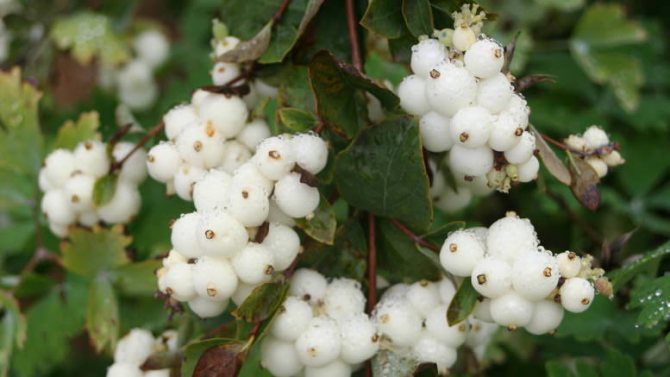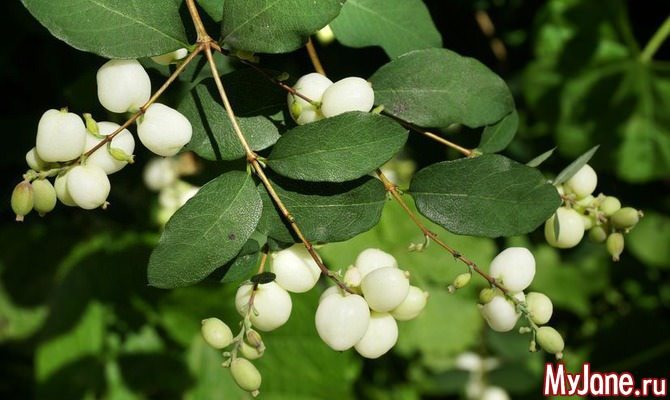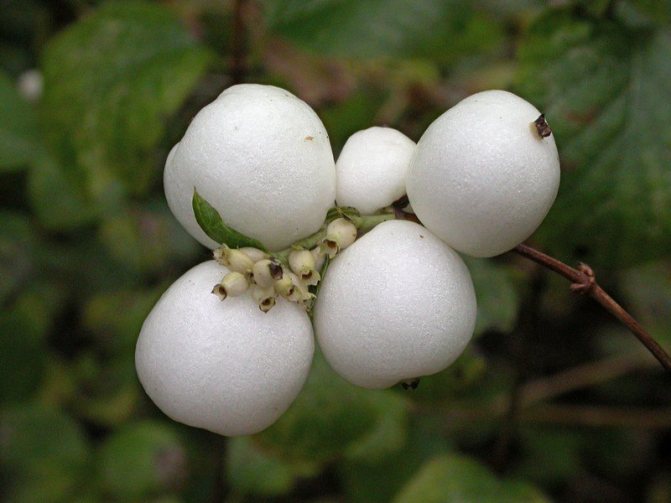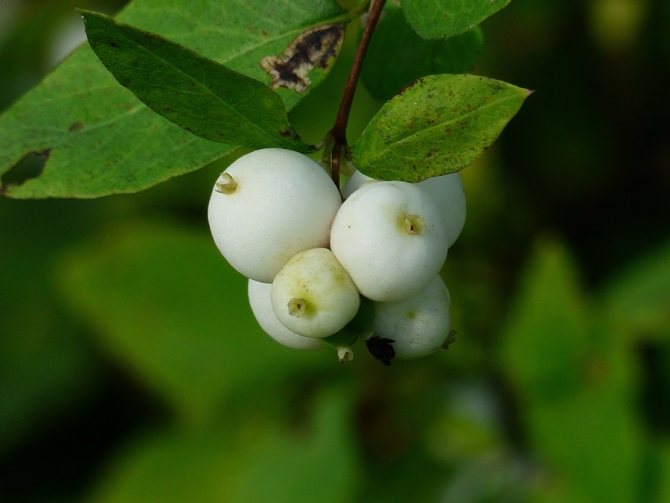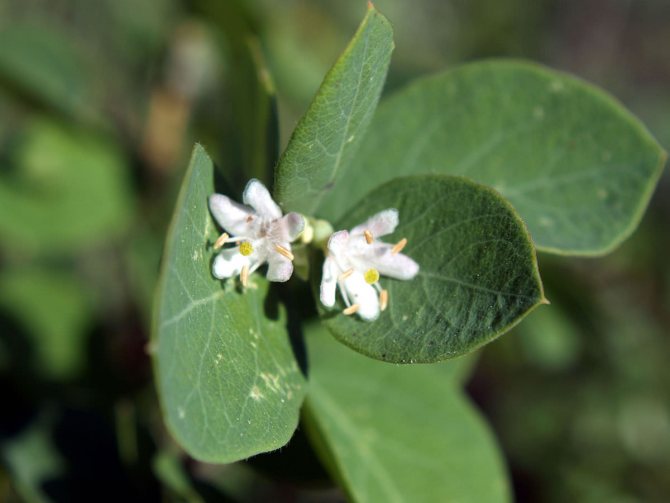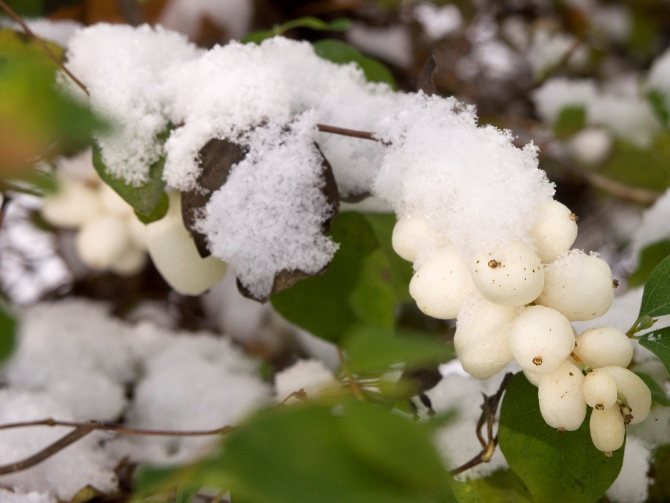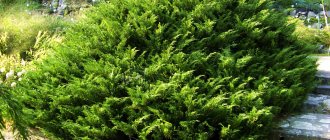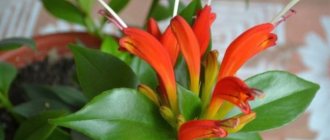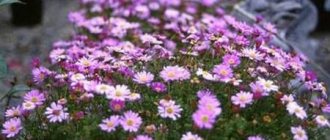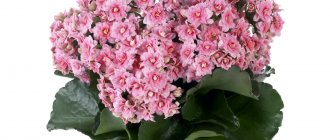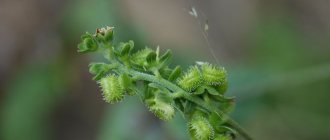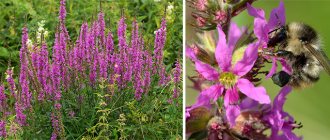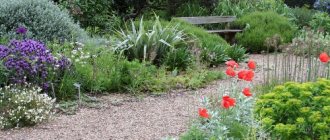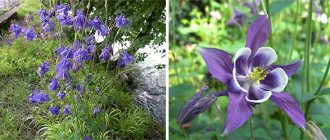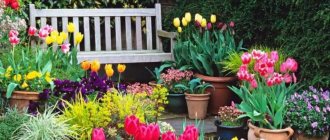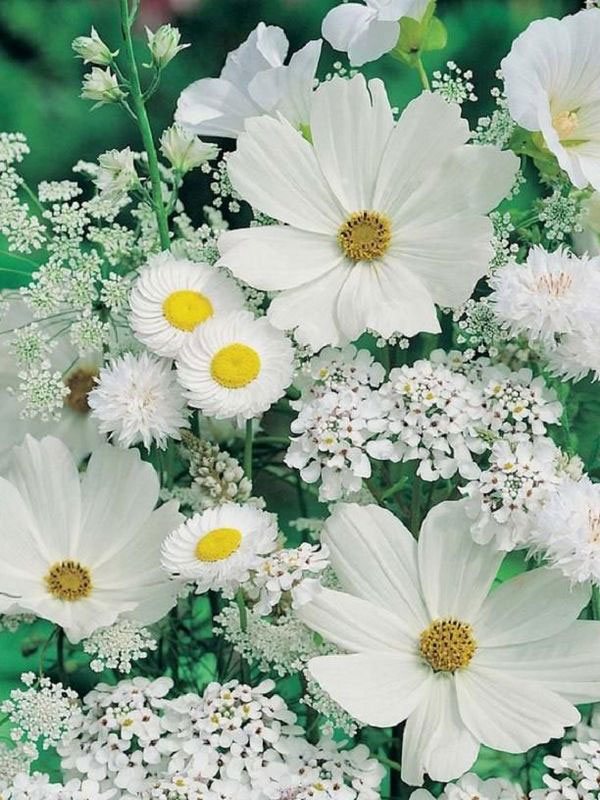
Recently, the design of flower beds (and sometimes even a whole garden) in one color scheme has come into vogue. Such monochrome solutions give the landscape an unusual and austere beauty. White flowers take a special place in this design.
White color will give any flower bed the effect of lightness and airiness. Will add elegance and romanticism to the garden. The wonderful combination of white flowers with green leaves and grass soothes and relaxes. It's not for nothing that many people like white.
The choice of plants with white flowers is very wide, these are annuals and perennials, shrubs and even flowering trees. It is possible to pick up such plants according to the flowering period, so that the flower bed or garden remains elegant at all times.
Thanks to the work of breeders, there are white-flowered varieties among all types of flowering plants. It's easy to get confused, although most of the colors are familiar to you. Let's try to figure it out a bit.
Ageratum
Fluffy shrubs of ageratum are also known as "long-flowered", and this is no coincidence - it blooms for a long time, and cut does not lose its decorative effect up to 2 weeks. There are about 60 types of ageratum on the market, so it will not be difficult to choose a flower to your liking.
Aloha white
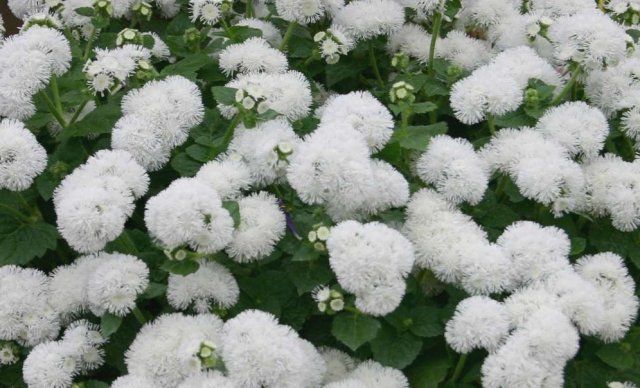

Ageratum is grown through seedlings, and the sowing of seeds is carried out already in March. After picking, the sprouts are hardened, and at the end of May they are planted in the ground. The flower prefers sunny places (it stretches in the shade and blooms poorly), neutral soils, abundant watering and regular (every 2-3 weeks) humic feeding. If you remove all wilted inflorescences in a timely manner, the bush will grow and bloom even more magnificently.
Gallery: snowberry (25 photos)
Alissum
The fragrant and unpretentious alyssum is often called the beetroot or sea lobularia, and it belongs to the Cruciferous family. It happens both annual and perennial, and it can be sown both for seedlings and immediately into the ground - in spring or autumn.
The flower is unpretentious in terms of soil, quickly grows in breadth, covering the entire allotted place with a solid carpet. Gratefully responds to regular watering and nitrogen fertilization. May suffer from traditional cabbage pests - fleas and caterpillars.
Perennial flowers
If you do not want to waste time on transplanting bulbs and constantly sowing annuals, then pay attention to perennial flowering plants. Many of them have white flowers and will form the basis of your composition for a long time.
First of all, I would like to note the spring lily of the valley (Convallaria), somewhat similar to him buy multi-flowered (Polygonatum multiflorum) loved by all garden chamomile or nivyanik (Leucanthemum). Beautiful Broken Hearts dicenter can also be snow-white, for example, Dicentra formosa Aurora and Dicentra White. All of these plants will help you decorate the shady areas of your garden with white colors.
Garden chamomile or Dee's daisy
Astilba (Astilbe), which is widely used in many floral arrangements, will delight fans of white with varieties such as Brautschleier, Bumalda, Weisse Gloria.
Fancy exceptionally white flowers aquilegia (Aquilegia) offer us the varieties Nivea, Alaska, Dove-white, Diamond.
Peonies with white flowers are represented by a large number of varieties, for example, double varieties Ballerina, Baronesse Schroeder, Edit M.Snook, Miss America semi-double, Jan van Leeuwen, Krinkled White, Lois Kelsey and many others.
Astilba "Weisse Gloria" Peony "Krinkled White"
A wide variety of white-flowered forms have and irises (Iris) such as Bubbling Lace, Lark Ascending, Arctic Wind, Zero.
In almost every one of the many types bells (Campanula) breeders have developed varieties with white flowers. And like a bell with a wide flower platycodon (Platycodon) also has a white-flowering variety Grandiflorus Albus.
It is impossible to ignore such a flower beloved by gardeners as phlox (Phlox). This plant also comes in many different varieties and species. Let's name some pure white varieties. These are Belosniejka, David, Pina colada, Neon Jade, Younique White, Panama, White Admiral and many others.
Platycodon "Grandiflorus Albu" Phlox "White Admiral"
Blooming late chrysanthemums (Chrysanthemum) will help preserve the beauty of the garden in the fall. You can pick up white varieties, varied in height and flower size. This will provide ample opportunities for their use in landscape design.
When decorating a flower garden, you can not do without undersized and ground cover plants. They are indispensable for alpine slides, rockeries, as well as for creating low curbs.
Allissum or lobularia (Alyssum) is a low-growing herb up to 20 cm, it can be annual and perennial. Small flowers are collected in lush brushes. Blooms in early summer. White-flowered specimens come in species such as sea (Benthamii, Compactum, Easter Bonnet White, Klein Dorrit, Schneeteppich) and Pyrenees.
Creeping evergreen periwinkle (Vinca) is traditionally blue in color, but this plant also has varieties with white flowers (Alboplena, Emily). Periwinkle of these varieties can create for you a beautiful rich green carpet of leathery leaves, against which the old five-petal flowers will stand out brightly.
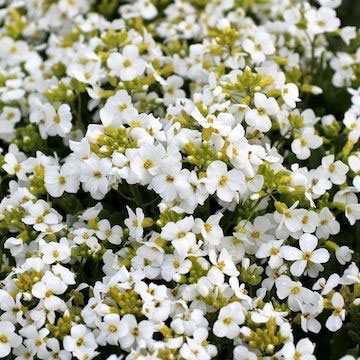

Arabis "Schneehaube"
Arabis or rezuha (Arabis) is an evergreen groundcover with silvery gray leaves (sometimes slightly pubescent). Its stems root well and form rugs. Miniature (up to 1.5 cm) white flowers are collected in a short raceme. Sorts Schneehaube, Plena.
Among climbing flowering plants, I would like to note the very popular clematis (Clematis). Beautiful flowers of various shapes and colors make this plant desirable for gardeners. For a white garden, you can offer some types and varieties.
- Straight clematis (Clematis recta) is a herbaceous perennial up to two meters high, requiring a garter. Huge loose inflorescences of small white flowers create a fragrant "foam".
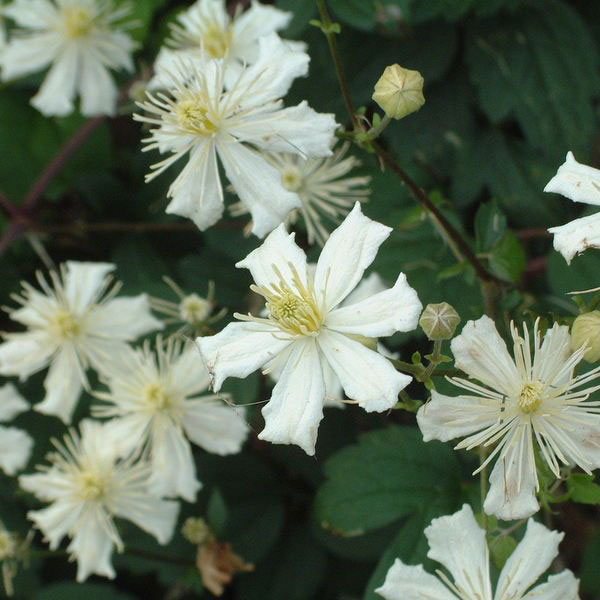

Clematis Fargesioides
- Fargesioides (Fargesioides) - unpretentious vine up to 7 meters high. In the middle of summer, milky white flowers bloom, which, against the background of green foliage, look like falling snowflakes (varieties Summer Snow, Paul Farges).
- Whole-leaved (Integrifolia) - a type of low-growing clematis, reaching only 0.5 m. It is distinguished by an unusual drooping shape of a beautiful bell flower with strongly curling sepals. White-flowered varieties: Hakuree, Baby White, Alba.
We also note such clematis as the semi-double variety with white flowers White Swan, the flowers of the Valge Daam variety have a subtle bluish tint that gradually disappears, and the Roko-Kolla variety has white flowers with a green stripe on each petal.
Aster
The variety of varieties of annual asters is so great that it is difficult to make a choice. Bushes can be from 20 to 120 cm high, with a wide variety of leaves, crown and flower shapes. When choosing seeds, check their freshness - already in the second year after harvest they lose up to 60% of germination.
Asters are grown both through seedlings (in March-April), and immediately in the open field, under a film cover. Flowers react positively to transplanting and picking, so you can not be afraid to move them around the site. Asters do not tolerate stagnant moisture and fresh manure.
Planting and leaving
When choosing a place for planting a snowberry, there is no need to think about whether it will grow in this particular area. The snowball feels great both in the shade and in the sun.Poor soils, sandy or stony, will not be an obstacle to planting and caring for a snowberry in the open field. However, the shrub will thank the caring gardener with intense flowering and abundant fruiting.
The shrub can be planted both in spring and autumn. The main condition for fast rooting of a plant is good soil moisture. Applying organic fertilizers will help the plant to take root. Having planned the landing site, you need to prepare it. For an autumn planting, it is necessary to dig holes about 60 centimeters deep and the same in diameter in a month, fill them with a mixture of crushed stone and a substrate consisting of humus, river sand and peat. Additionally, for each bush is added:
- superphosphate - 200 grams;
- dolomite flour - 200 grams;
- wood ash - 600 grams.
For planting in the spring, all work must be done in the fall.
If you plan not for a single or group composition, but for planting a snowberry as a hedge, you need to dig a trench 45 centimeters wide and 60 centimeters deep. The planting density is 3-4 plants per 1 running meter.
After planting the plant, the soil around must be tamped, well watered at the rate of 1.5-2 buckets per bush and the trunk circle should be covered with a 5 cm layer of peat. After planting, you need to make sure that the root collar of the seedling is at ground level. Watering the seedlings is necessary for 5-7 days after planting, subject to dry weather.
An unpretentious snowberry will grow, even if you do not care for it at all. But like any plant, surrounded by care, it will look healthy and well-groomed with just a little work.
Watering a snowberry
In dry summers, the shrub needs watering, which is best done in the evening in the amount of 1.5-2 buckets for one plant. The soil in the near-trunk circle must be loosened and weeded. If the weather is humid, watering the snowberry is not required. In autumn, the ground around the plant must be dug up.
Necessary feeding
A snowberry can do just fine without feeding. But how will it bloom and bear fruit if you feed it with organic fertilizer! Only 2 times. In the spring, take 5-6 kg of humus and add 100 grams of potassium salt and superphosphate, add under the plant. Then in the summer, when the fruits begin to set, you need to use any fertilizer for berry crops.
Pruning and shaping the crown
In the spring, it is necessary to conduct a control examination of the plant and identify branches that have dried up and damaged during the winter. Cut off such shoots completely. There is no need to be afraid to prune healthy branches as well, as the plant lays flower buds in new shoots. You need to shorten healthy branches by half the length. Slices should be processed with garden pitch if their thickness is more than 5 mm. Young strong shoots will be grateful to the bush for the procedure.
Winter period
When choosing a variety of snowberry, it is necessary to pay attention to the frost resistance of the plant. If the variety is cold-resistant, then the shrub does not need additional shelter and will withstand frosts down to -35 ° C. In regions with harsh winters, even a frost-resistant variety of snowberry must be hilled high and covered with spruce branches and dry leaves.
When the question arises of what to plant in a summer cottage or a personal plot, the choice in favor of a snowberry is obvious. For experienced and novice gardeners, an important factor is the unpretentiousness of the plant and its unconditional decorative effect. This will allow you to realize your design abilities for landscape gardening of the site, without spending a lot of time and effort.
Balsam
Garden balsam, in common parlance called "Vanka wet" for the drops formed on the leaves, is a lush bush, growing from 20 to 50 cm. It is sown on seedlings early, in mid-February, then dive and pinch. In the ground, balsam is planted on the east or west side of the site, since he does not like either a thick shadow or bright sun.
Caring for balsam is simple: just water it on time, feed it with nitrogen-potassium mixtures and cut off wilted inflorescences.
Spathiphyllum
Spathiphyllum is a bright, bright plant with large shiny leaves and unusual flowers. It is an evergreen representative of the aroid family. Known under the name "white sail" for external resemblance and "female happiness", it is believed that he is able to bring good luck to his mistress. Spathiphyllum has practically no stems, its oblong leaves grow directly from the root. Floral arrows with original flowers, resembling a small ear covered with a snow-white veil, also behave.
The main purpose of the petals is to lure insects for pollination. Leaves grow densely, forming thickets. They have an oblong pointed shape with distinct veins. If we talk about the beneficial qualities of spathiphyllum, then it has high phytoncidal properties, destroys pathogens. In addition to useful components, it contains toxic substances, this must be borne in mind when working with a plant.
Types of spathiphyllum:
- profusely blooming;
- Wallis;
- dominoes;
- canniferous;
- Picasso;
- Chopin;
- heliconiiferous;
- spoon-shaped;
- sensation.
Both tall and dwarf varieties of spathiphyllum have been bred.
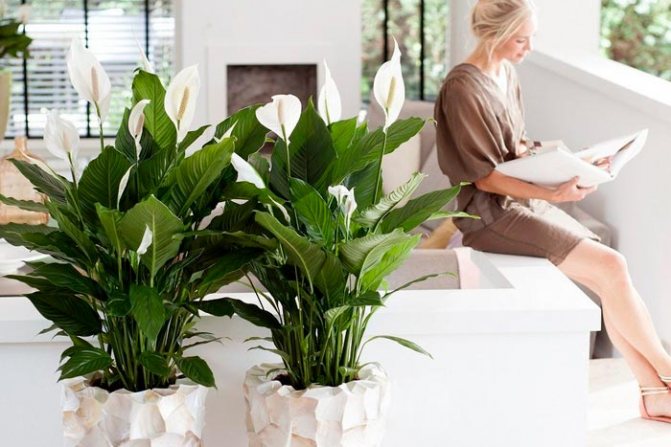

Begonia
Among the many types of begonias, annuals are especially popular for their decorativeness and unpretentiousness. Most often they are grown in pots, pots and boxes as single plants.
Begonia seeds are sown in February, pretreated with fungicides, and then dive into pots. On the site, they prefer sunny and warm places, they need regular (once every 2 weeks) phosphorus-potassium dressings.
Houseplants
If you want to decorate the room with flowers with pink buds, you should choose any of the presented plants:
- Mandeville - has lush green vegetation, therefore it is grown as an indoor liana, reaching a length of 3 meters. You can also prune this plant and grow it like a bush. It blooms profusely from the very beginning of the growing season. The foliage should be sprayed frequently and watered abundantly. It is worth keeping the vine on a sunny window.
- Fuchsia has a long flowering period from spring to autumn. She throws out a lot of peduncles, but after flowering, experienced gardeners get rid of her. In order not to do this, you can remove the plant for the winter in a cool place by cutting off the shoots. Watering is scarce in winter and plentiful in summer. During the growing season, it is imperative to spray the plant, and in the spring, transplant the resulting cuttings into a pot more freely.
- Hydrangea blooms with voluminous caps. Caring for her is extremely difficult for novice florists. Watering is best done with rainwater, and in the summer, expose hydrangeas to the open air. Spraying should be carried out periodically, and after flowering, do not forget to water and feed. The first half of winter, seedlings should be kept in a cold, but not freezing room, and then transferred to a warm and light one.
- Rheo can be grown as a single plant or as a bush. It must be protected from drafts and kept warm all year round. The plant can be propagated in the summer by stem cuttings. In summer, it is recommended to place in a bright place without direct sunlight, water often and spray the foliage.
You can grow these indoor plants regardless of the climatic zone of your region. With the right care, you will enjoy them for years to come.
Verbena
Branched verbena bushes reach 25-45 cm in height, bloom from June until frost and are completely undemanding to soil and fertilizers. With proper care, each of their branches turns into a real bouquet and stands after cutting for up to 10 days.
Vervain is sown in mid-March, a month later it dives, and a month later it is pinched and planted in the ground. For the maximum number of flowers, the plant is fed before and during flowering with a mixture of nitrophoska and Agricola (1 tablespoon per 3 liters of water per 1 square meter).
Gardenia
Gardenia is an evergreen plant of the madder genus. It grows as a shrub, sometimes as a small tree. Indoors it grows up to 60-100 cm. Most species are evergreen. The leaves are small, arranged in pairs or in a ring of three. They are dense, leathery, glossy. The color of the leaf plates changes from light to dark green. The plates are covered with veins. White flowers have a tubular calyx containing 5-9 stamens. During flowering, the entire room is filled with a delicate aroma.
Terry gardenia varieties are widespread in indoor floriculture; they are not inferior in beauty to roses.
Indoor jasmine gardenias:
- Veitchii;
- Fortuneana;
- "The first love";
- White Gem;
- "Variegata".
The buds appear at different times of the year, sometimes even in winter. Gardenia Citriodora is a rare dwarf plant in our country, covered with tiny flowers 1–2 cm in diameter, smelling like an orange.
Carnation
Among the many types and varieties of carnations, two popular annuals can be distinguished - Chinese and Shabo. Both of them are bright, interesting, but the second will also delight you with its aroma.
In terms of cultivation, the Chinese carnation is much easier, one might say, sowed and forgot. In addition, it multiplies by self-sowing and will rise again the next year - just water and weed in time. With Shabo, everything is more complicated - it requires early sowing (in January), double picking (in the phase of 2 and 6 leaves), as well as tying in a flower bed.
Types of clerodendrum
Before learning how to care for clerodendrum at home, you need to familiarize yourself with the most popular varieties and choose the right type for yourself.
Thomson's Clerodenrum (K. thomsoniae) - a climbing liana with thin fast-growing shoots, gorgeous gorgeous white-red flowers with "bloody" droplets on long stamens. Sheds leaves for the winter.
Clerodendrum the fairest (K. spesiosissimum) is an evergreen shrub reaching 3 m in height. Large glossy leaves, heart-shaped, pubescent with villi. The inflorescences are collected in pretty red panicles.
Dahlia
In our climate, dahlias have to be grown from scratch every year, and this must be done both from the tuber and from the seeds. These flowers can be of various sizes and shapes, therefore, when planning their planting, you need to choose a spacious place in the sun in advance.
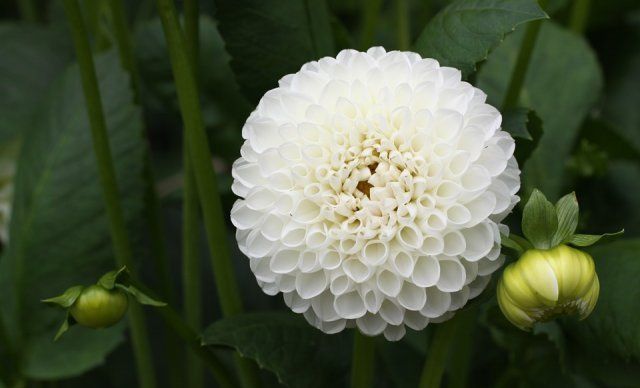

When growing dahlias from seeds, they are sown at the end of March, dived in the phase of 2 leaves, fertilized and pinched in the phase of 4 pairs of leaves, and then planted in the ground. Between the bushes of low-growing dahlias you need to leave 25 cm, medium-sized ones - 50 cm, tall ones - 70 cm.Further care includes watering, weeding, loosening and applying mineral fertilizers 2 times a month.
Spring flowering pink perennials
Badan thick-leaved (Bergenia crassifolia).
Also known as Mongolian tea and Saxifrage thick-leaved. Widespread perennial crop with large, leathery, rounded leaves. It blooms in spring with bell-shaped pink flowers.
Plant height usually does not exceed 50 cm.
It is undemanding to the composition of soils, but does not tolerate stagnant moisture, especially in the spring.
It goes well with aquilegia, daylilies, geraniums, irises. The most common varieties are ‘Abendglut’, ‘Ballawley’ and ‘Morgenrote’.
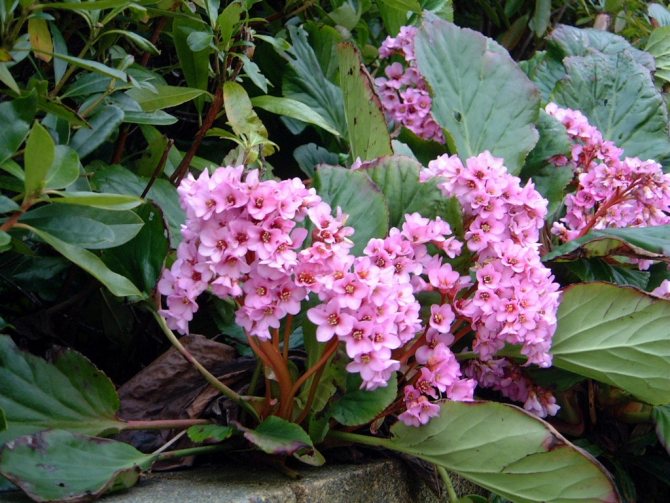

Badan thick-leaved
The center is magnificent (Dicentra spectabilis).
Also known under the popular name Broken Heart.
Herbaceous perennial up to 90 cm high.
It is characterized by erect well-leafy stems and heart-shaped flowers. The flowering period is in May. It can successfully grow both in open sunny areas and in conditions of light partial shade.
It goes well with daffodils, kupena and tulips. One of the most popular varieties is 'Bacchanal'.
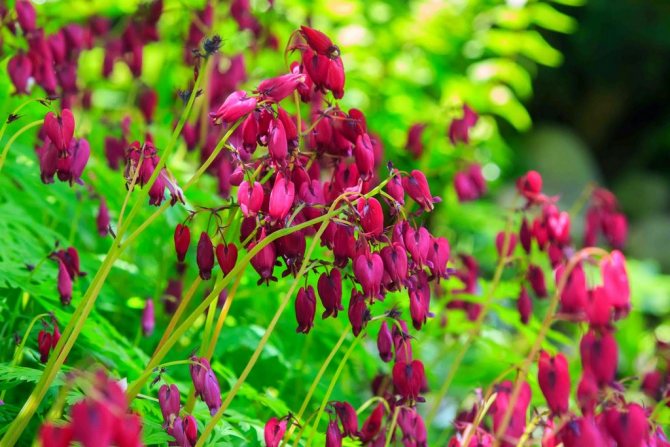

Di.
Aubrieta cultural (Aubrieta x cultorum).
Perennial plant with small leaves.
The height of the bushes does not exceed 20 cm.
The flowering period is in May. Unpretentious and not demanding on growing conditions.
Can be combined with alyssum, subulate phlox and Iberis. The following varieties of obriety are known: ‘Barkers Double’, ‘Gloriosa’ and ‘Joy’.
Aubrieta cultural 'Joy'
Common primrose (Primula vulgaris).
Unpretentious spring-flowering perennial.
It is characterized by oblong-oval wrinkled leaves.
Plant height does not exceed 20 cm.
It blooms very early, in early April. Prefers rather loose and nutritious soils.
Can be planted together with scilla, muscari, low varieties of irises. The following varieties are good: ‘QUAKERS BONNET’, ‘KEN DIARMEN’, species-specific pink primroses - Japanese, cortex-shaped, fine-toothed and others.
Common primrose 'QUAKERS BONNET'
Phlox subulate (Phlox subulata).
Perennial creeping plant no more than 20 cm high.
It is characterized by small pointed leaves and flowers about 2 cm in size.
The flowering wave lasts from mid-May to late June. They grow best on poor soils.
They are mainly used in single plantings to create alpine slides. Varieties: ‘Appel Blossom’, ‘Daisy Hill’, ‘Samson’, ‘Fort Hill’.
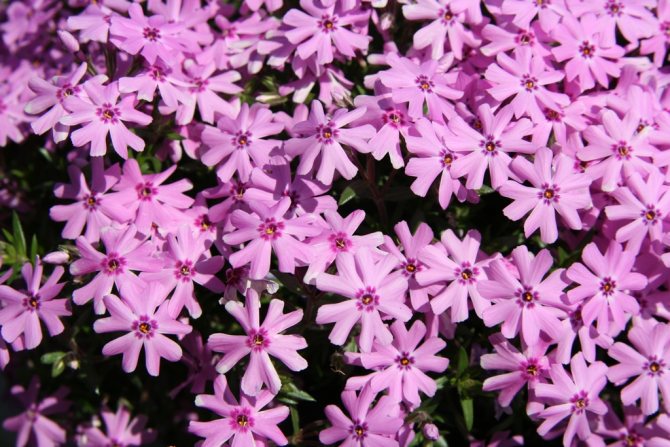

Phlox subulate 'Fort Hill'
Gypsophila
Gypsophila is the most popular companion of roses in bouquets, and just a charming flower. It can be grown without difficulty, and in a cut it costs more than 10 days.
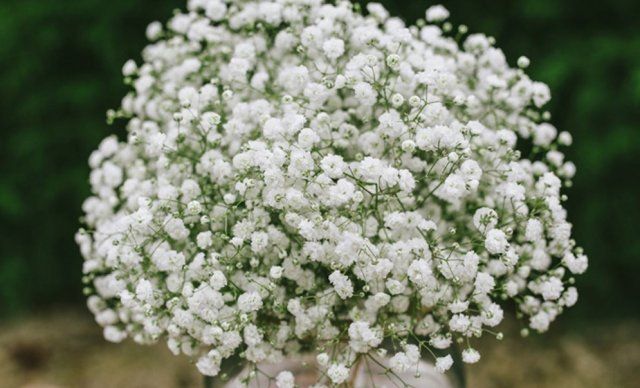

Gypsophila seeds are sown directly into the ground in mid-April, since it does not like transplanting and often dies when diving. From the name of the flower it is clear that it prefers light calcareous soils. After the seedlings emerge, they need to be thinned out, leaving 15-20 cm between the plants, and then all that remains is to water the bushes and wait for flowering.
The soil
The soil, typical for areas of natural growth of Clerodendrum, is very fertile and contains many useful substances. Therefore, at home it is better to cook a similar nutrient substrate on your own:
- peat - 30%;
- leafy land - 30%;
- clay soil - 20%;
- sifted sand - 20%.
If you decide to use the ready-made soil from the store, add some sand to it. Disinfect the soil before use to avoid fungal or pest infestations.
Godezia
Godetia bushes, depending on the variety and type, can reach 20-60 cm in height, have different shapes and colors of leaves, and the diameter of their flowers can reach 3-10 cm. Godetia blooms from July until frost and perfectly tolerates weather troubles.
You can sow godetia directly into the soil at the end of April in a sunny area with neutral or slightly acidic soil. Caring for godetia is simple: it is enough to loosen and water it in a timely manner, and tie tall varieties to a support.
Biological description [edit | edit code]
Deciduous shrubs 0.2-3 m high.
Buds with two pairs of outer scales. Leaves are opposite, simple, short-petiolate, whole-edged, sometimes notched-toothed on coppice shoots, without stipules.
The flowers are regular, in axillary or terminal racemose inflorescences, located in the axils of the upper leaves.
The fruit is a spherical or ellipsoidal succulent drupe, white, red or black, with one to three oval, more or less compressed bones.
Sweet pea
In southern climates, sweet peas have been growing for many years, but here they are grown as an annual. Ideal for vertical landscaping (arches, pergolas, gazebos).
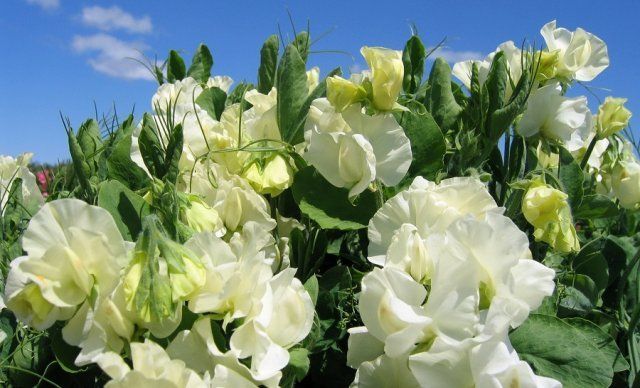

Sweet pea seeds are tough, so they need to be soaked before sowing. In the development phase of 2-3 true leaves, the seedlings are pinched and fed with Kemira (2 g per 1 liter of water). You need to plant peas in the ground at the end of May, immediately to the supports, and all the buds that appeared before planting will have to be cut off. Watering the peas should be done regularly, not letting them dry out, but feeding is optional.In the fall, the plant will have to be removed, and it will be possible to re-plant in this place only after 5 years.
Pink color of flowers: meaning and symbolism
In bouquets, pink flowers are found a little less often than red or white ones. What is their significance? For Colombians, pink anthurium was traditionally in the bedroom of the newlyweds during the honeymoon, promising them a happy family life. Raspberry-pink kallas, presented to an unmarried girl, spoke of admiration for her beauty and admiration for her. In a broader sense, pink flowers are softer than red in their saturation, but they belong precisely to this primary color. Therefore, its main meaning is love, but tender, quivering, mixed with reverence for the addressee. Often, pink flowers are given to those who want to show respect, and they are also presented as a sign of courtesy, politeness and courtesy.
A bouquet of pink clover was given for good luck, or with an interlinear recognition that the one to whom this flower was presented brings happiness to the donor himself. Gentle mallow - please pay attention, believe, forgive, treat what happened with understanding and condescension. Pink lush hats of peonies, not so long ago ahead of even roses in demand, are able to say more than the queen of flowers: they promise to give the whole world to the one to whom they were given. Unlike a rose, they do not shout about the donor's feelings, but guarantee his reliability in marriage and fidelity. Dreams of a joint future and not letting go of love symbolize bright pink phloxes, and the crimson gladiolus assures of the sincerity of intentions and feelings.
Iberis
Iberis flowers can often be found in designer wedding bouquets, but otherwise it is little common and almost unknown. In landscape design, it is used for edging garden paths, ridges and alpine slides.
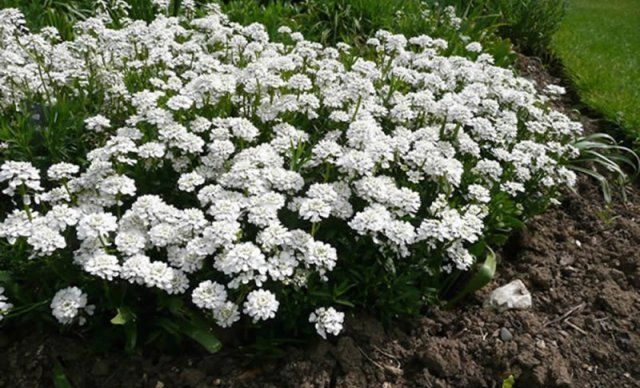

Iberis is sown in open ground in April, and it blooms until September. Even inexperienced flower growers will like the cultivation of Iberis, because it does not need to be fed, it is worth watering only in the hottest season, and all care comes down to cutting off excess branches and removing dry peduncles.
Summer pink perennials
Alpine aster (Aster alpinus).
Perennial plant with sturdy stems about 30 cm high.
Has a basal rosette of oblong leaves. The inflorescences of the basket are 4 to 5 cm in size. The flowering period is in June.
An undemanding plant, the main thing is a sunny location. Combines with sedum, rudbeckia, irises. Varieties: ‘Rosea’, ‘X Pink’, ‘Ruber’, ‘Happy End’.
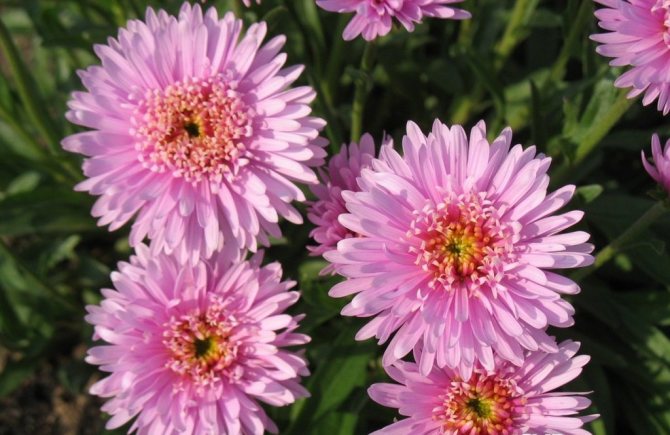

Alpine aster 'X Pink'
Pinnate carnation (Dianthus plumarius).
A beautifully flowering perennial about 20 cm high.
It is characterized by bluish leaves and oblong-linear leaves. Blooms in June.
It is not demanding for growing conditions.
Combines with decorative cereals, edelweiss. Pink-flowered varieties: ‘Highland Hybrids’, ‘Single Mixed’, ‘Roseus’, ‘Sonata’.
Pinnate carnation 'Roseus'
Blood red geranium (Geranium sanguineum).
Creeping perennial up to 15 cm high.
Overwintering leaves are light green. Flowers no more than 2.5 cm in size. The flowering period is in July.
Garden geranium is widely used to create borders, flower beds. Recommended varieties: ‘Lancastriense’, ‘Striatum’, ‘Nana’.
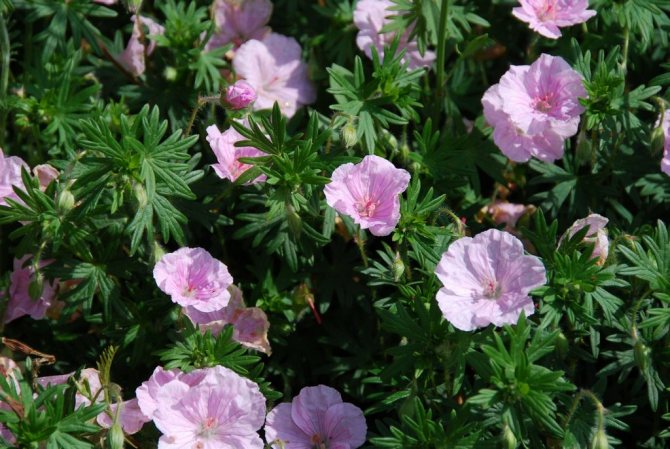

Blood-red geranium 'Striatum'
Sedum false (Sedum spurium).
Perennial with creeping stems and fleshy dark green leaves. Inflorescences are corymbose type.
The flowering period is in July. Prefers fertile soils with good drainage and a sunny location.
Sedum is mainly used to create carpet compositions. Varieties: ‘Bronze Carpet’, ‘Voodoo’, ‘Splendens’, ‘Roseum’.
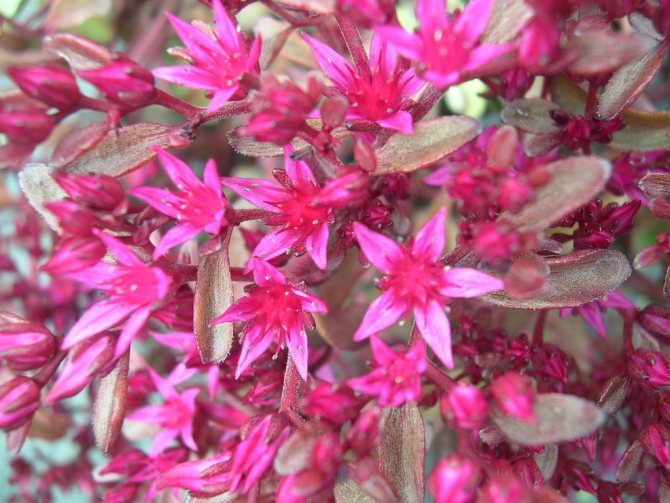

Sedum false 'Voodoo'
Pyrethrum pink (Pyrethrum roseum) and numerous garden forms and varieties derived from it (Pyrethrum hybridum).
Otherwise, the poplar is red or bright red tansy (Tanacetum coccineum). In foreign catalogs, item pink is presented under this name.
Herbaceous perennial no more than 70 cm high.
It is characterized by an erect stem and dissected leaves. Flowers - baskets.
The flowering period is in June. They prefer moderately fertile soils and open areas.
Combines with yarrow, bells and cornflower. Varieties: ‘Brenda’, ‘E. M. Robinson ',' Lord Rosebery '.
Pyrethrum pink 'Laureen'
Dittany (Dictamnus albus).
Rhizome plant up to 80 cm high.
It is characterized by strong erect stems and rather large irregularly shaped flowers. The flowering period is from late June to July.
Grows well in all types of soils. Combines with loosestrife, tenacious, cootula.
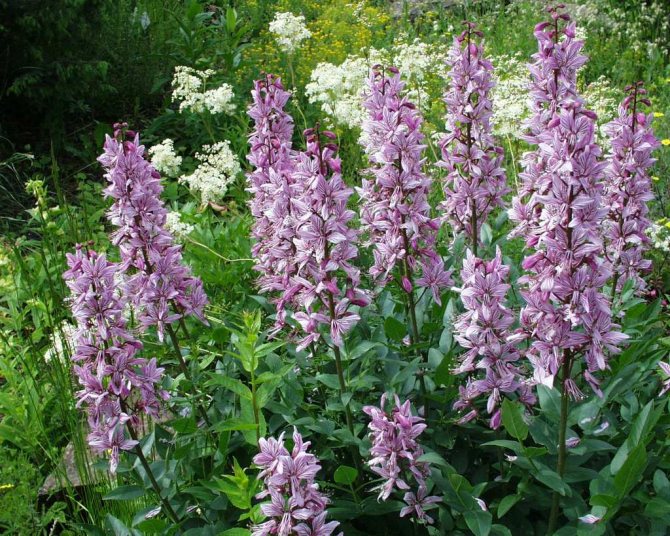

Dittany
Cleoma
In cleome, not only spectacular, like exploding flowers are attractive, but also an unusual smell. The Germans compare it to a spider, the French to a splash of champagne.
You can sow cleoma seeds in the ground (in November or April) or for seedlings in the spring. Seeds sprout for a long time (up to 3 weeks), in the phase of 2 leaves they are dived into separate pots, and after another 2 weeks they are pinched. In May, the seedlings are sent to the ground, to a sunny area. Care comes down to watering, loosening and applying mineral fertilizers for flowering plants every 2-3 weeks.
Hoya
Hoya is an evergreen plant of the Grimaceae family, growing in the form of a liana or a shrub. Liana uses trees as a support. The plant has oval leaves with a pointed end, young leaves are shiny, with age they become dull. Flowers are collected in decorative inflorescences, which are located on the core branches, resembling a five-pointed star. They are small, up to 2 cm.
The plant is characterized by the presence of a pentagonal crown located in the center of the corolla. It was formed as a result of the splicing of plant parts and rises above the petals. The flowering plant has a strong odor and produces nectar that attracts insects.
Kosmeya
Delicate cosme daisies can be found in any corner of our homeland. This is no coincidence - you still need to try to find a whiter, unpretentious flower. It is enough to sow the seeds of the cosmos on the site once, and it will grow itself year after year, inseminating.
It is possible to sow kosmeya in open ground both in spring (in April) and in autumn (in September). Watering cosmos is carried out once a week, fertilization with any complex for flowering plants - three times per season (before budding, during it and at the beginning of flowering). If the bushes grow strongly, they can be cut off - this will not affect flowering.
Transplant, pruning
Vines grow very quickly, and they have to be replanted quite often. In order for clerodendrum to bloom profusely, you need to adhere to certain rules when transplanting.
In early spring, with the beginning of the growing season, the overgrown plants need to be transferred into larger pots - this procedure will be the most gentle for their root system.
Pruning - this is another way to make the plant bloom profusely and for a long time, to have beautifully colored strong leaves. At the end of winter and in autumn after flowering, remove wilted flowers and leaves, give the plant a beautiful shape.
Lavatera
Lavatera, hautma, or wild rose, became incredibly popular in garden design 20 years ago and still hasn't gone out of style. In warm climates, it can be planted directly in open ground, but in the middle lane it is advisable to grow it through seedlings.
Lavater seeds are sown in March, they are actively illuminated and, without diving, are planted in open ground in May. They water it only in drought, loosen it while the plants are still small, and then simply cut off the wilted flowers. Lavater is fed a couple of weeks after planting and during the budding period (for the first time with nitrophosphate, in the second with sodium sulfate and potassium sulfate, 1 tablespoon per 10 liters of water).
Description of varieties of snowberry
Snowberry (Symphoricarros) are rather short shrubs. The maximum height of the above-ground part, as a rule, does not exceed one and a half meters. The branches are long and thin enough. During the ripening period of berries, under the weight of the bunches, the shoots go down, which gives the plant an almost regular spherical shape.
The foliage is slightly elongated, ovoid, with a green upper leaf plate and a bluish tint on the back. The berries are collected in a brush, have a rounded shape, and reach a diameter of 10 mm. Fruit coloration directly depends on the species characteristics.
Levkoy
Levkoy or mattiola is a plant that came to gardens and parks centuries ago. It is preferred by fans of the traditional park style, and its name is translated from Greek as "white violet".
Levkoy seeds are first soaked for a day, then stratified for 3-4 days in the refrigerator and only then sown, sending them to a dark warm place for 5 days. After the emergence of shoots, they are sent to the cool, hidden from direct sunlight, and after another 10 days they dive. Levkoy is planted in the ground in the evening or on a cloudy day at the end of May, on a well-lit and drained area far from the garden, since the flower often infects the cabbage flea. Care comes down to regular watering, applying phosphorus-potassium fertilizers and loosening.
Phalaenopsis white orchid
Orchids, which include the phalaenopsis orchid, are an ancient family of plants. A blooming orchid is an excellent decoration for an apartment. Pure white color is rare, most often there are specks or edging on the petals. It can take a long time to list hybrid varieties and varieties. Shoot sizes vary from dwarf to specimens reaching a length of 1 m.
White orchid varieties:
- Phalaenopsis Royal Orchid loved by many because of its large flowers, reaching a diameter of 15 cm.
- For "Wands" characteristic caramel aroma, long flowering. The plant produces up to four peduncles, each of which blooms 15 flowers.
- "Butterfly" - an orchid whose flowers resemble moths.
- "White heron" (Habenaria radiata) got its name from the flowers that resemble a flying bird with delicate wings.
All orchid varieties are conventionally divided into "mini", "midi" and ordinary. They vary in the size of buds and leaves.
Orchids have an unusual requirement for a pot - it must be transparent so that the roots receive enough light for good photosynthesis.
Poppy
Despite the stereotypical opinion that poppies should be red, there are also white varieties among them. Their flowers are small, the plants themselves are unpretentious and are great for Moorish lawns or natural-style gardens.
Before sowing, poppy seeds are stratified and then scattered onto moistened sandy loam or loamy dug soil. After 4 weeks, seedlings need to be thinned, and then regularly watered and rid of weeds.
Is it a poisonous shrub with white berries?
Round berries of a snow-white color ripen at the end of summer, after which they hibernate on a shrub plant until the onset of spring heat. Despite the rather attractive and seductive appearance, such berries are absolutely inedible and can cause poisoning. Nevertheless, the toxic effect is exclusively on humans, and many birds eat the fruits with great pleasure in the winter. Domestic flower growers use snowy berries only as an ornamental plant.
Also read: Oleander in the garden: how to grow a luxurious plant
Petunia
Modern varieties of petunias make gardeners truly lose their heads - bushes of all sizes, colors and shapes do not leave anyone indifferent. You can grow this flower in flower beds, balconies and in hanging pots, and it will bloom until the very frost.
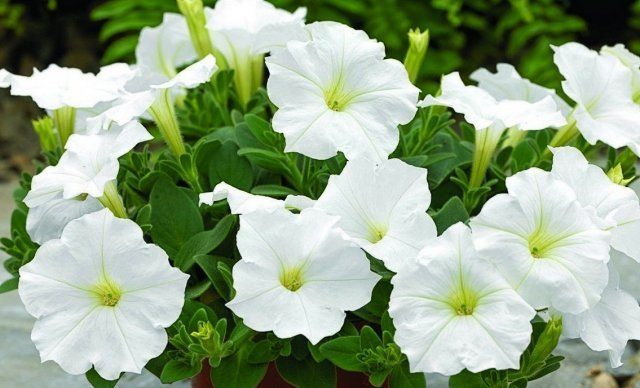

Petunias are sown on seedlings at the end of February and after the emergence of seedlings, they begin to actively light up. It should always be very humid in the tray with crops, but at the same time they need to be ventilated every day, and the film or glass covering the tray should be wiped.In the phase of 3-4 leaves, the seedlings dive, and after a week they begin to feed them with nitrofoskoy, Kemira or Solvent according to the instructions. Petunia is planted in the ground after the threat of return frosts has passed, in a sunny, well-fertilized place. You need to feed and water the petunias very often, and then be sure to loosen them.
Flowering shrubs
Speaking of creating a white garden or flower garden, one cannot ignore the flowering shrubs that have white flowers.
Spirea (Spiraea) is a shrub that has gained popularity for its unpretentiousness and abundant flowering. A variety of spirea, blooming in spring, Spiraea vanhouttei is popularly called the "bride". Its sprawling branches bending to the ground are densely covered with white umbrella-shaped inflorescences, consisting of small flowers. Blooms in May-June. There are many more species of this shrub and in each of them there are specimens with white flowers. Moreover, they have a wide range of flowering periods (from spring to late autumn).
It is impossible to forget about the clouds of the beauty's inflorescenceshydrangeas (Hydrangea). This shrub will adorn any composition. Let's note the most popular pure white varieties. Treelike hydrangeas - "Annabelle", "Sterilis". Paniculata - "Kiushu".
Everyone knows unpretentious bushes lilac (Siringa vulgaris), but this does not make her less beloved and attractive. No one is left indifferent by chic cone-shaped inflorescences with an amazing aroma. The variety of varieties with white flowers is simply amazing. These are simple ones - Lebedushka, Monument, Flora. Terry - Zashchitnikam Bresta, Mme Lemoine, Krasawica Moskwy. And also thick double - Pamyat ’o Kolesnikove, d. Alice Harding, Mme Casimir Perier.
Suitable in any type of garden, unpretentious and flowering shrub weigels (Weigela) will decorate the white garden with varieties Alba, Candida, Black and White. Planting and caring for a weigela will not cause much trouble, even for novice gardeners.
Erika (Erica) - an evergreen shrub from the heather family with needle-shaped leaves also has varieties with white flowers. These are Alba, Snow Queen, Golden Starlet, Springwood White, Silberschmelze, Silver Bells and others. It blooms with elongated bells forming an inflorescence-ear. A beautiful plant, but needs a winter shelter.
Very unpretentious shrub snowberry (Symphoricarpos) blooms in the spring with small white (sometimes pale pink) flowers, but the main thing is that by autumn the flowers turn into white balls-fruits, which retain their decorative effect even with the onset of cold weather. Suitable varieties: Albus, White Hedge, Rivularis.
Erica "Golden Starlet" Snowberry "Albus"
And even the habitually yellow forsythia there is an unmatched white-flowered version of Forsythia abeliophzllum.
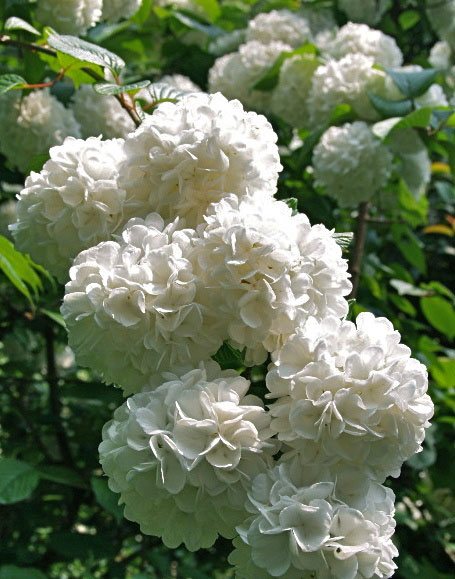

Kalina Buldenezh
There are varieties with white flowers in hibiscus (Hibiscus), jasmine (Jasminum), buddleys (Buddleja), actions (Deutzia), viburnum Buldenezh (Viburnum Boule de Neige), rhododendrons (Rhododendron), scum (Cotinus) and in numerous species of the garden queen - roses.
Tobacco
Fragrant tobacco is popular not only among insects, but also among people, because this honey plant has a truly incredible aroma and attractive appearance.
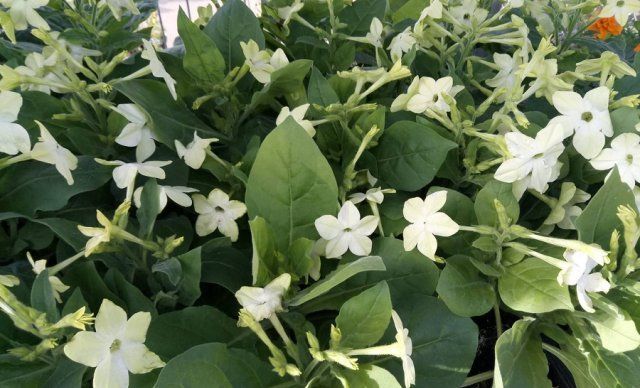

You need to sow tobacco at the end of February, after keeping the seeds for a couple of days in a damp cloth. In the phase of 2 leaves, the tobacco is dived, and after rooting, it is pinched in separate pots. It is transferred to open ground at the end of May, choosing illuminated areas without drafts. Fragrant tobacco is often watered, but it is not necessary to feed it in normal soil.
Description of the garden with pink flowers
Every romantic will love a garden plot in which crops will be selected in pink colors. It is these plantings that exude benevolence, tenderness and optimism. Flowers with pink flowers will help to change a shady garden to a more cheerful and elegant one, relieve a sad mood even in bad weather outside.
There are a large number of crops with pink inflorescences, each gardener will be able to choose the most suitable variety for himself. For example, it is allowed to plant bulbous spring flowers in the garden - tulips, muscari, hyacinths or perennial brands.
At this time of the year, hellebore flowers or thick-leaved bandana will look especially beautiful.At the end of the spring season, with the onset of summer, they can be replaced with herbaceous phlox, obriety, funny daisies or especially lush peonies.
In summer, the following flowers look especially beautiful on the site: purple echinacea, carnations, exquisite varieties of irises and diastia. Until the temperature drops, the garden will be decorated with joyful asters and bright Korean chrysanthemums.
Zinnia
This charming and unpretentious flower has been popular for more than five hundred years - it is grown in most civilized countries of the world, and it has managed to be a symbol of one of the states in the United States.
Sowing zinnia in the ground in May is possible only if you are sure that the frost will not return. If you are not sure, it is better to grow seedlings and harden them. Zinnia does not like picking, so sow its seeds, previously soaked in Epin's solution, 2-3 pcs. in peat pots. Seedlings love bright light, and at the end of May they are ready to leave for a permanent place. Plant it on sunny, well-fertilized areas since autumn, at a distance of 30 cm from each other. Care consists in watering at the root, loosening and regular fertilizing with mineral fertilizers with a low nitrogen content. You can prolong the flowering of zinnia by regularly removing dried flowers.
Of course, it's impossible to tell about all the annuals with white flowers, so if we forgot to mention someone, or you have your favorite that was not included in the selection, share its name and photo in the comments.
Bulbous
Traditionally, white bulbous flowers are snowdrop (Galanthus) and very similar to it white flower (Leucojum), and the white flower has varieties that bloom not only in spring, but also in summer.
Cute bouquets bloom in April chionodox, the white color is represented by the varieties Chionodoxa luciliae alba and Chionodoxa gigantea alba. Beautiful large-flowered variety of white crocus - Crocus Jeanna D'Arc.
Among the great variety of varieties daffodils and tulips we will present only a few. Daffodils (Narcissus) with white flowers: Beersheba, Mount Hood, Ice King, Poeticus Plenus, Cheerfullness. White tulips (Tulips): White Liberstar, Cardinal Mindszenty, Daytona, White Parrot, Tres Chic, Spring Green.
Crocus "Jeanna D'Arc" Tulip "White Liberstar"
White lilies are also very numerous, I would like to mention such varieties as Appleton, Annemarie's Dream, New Wave, Speciosum Album, White Heaven, Casa Blanca. Caring for them is simple, lilies are transplanted in the fall.
Gladioli (Gladiolus) white domestic selection is so widely represented that it is very difficult to choose several of them. You can name such as "Moscow white stone", "Snow White", "White Bear", "White fringe", "Poplar fluff" and many others.
It will be useful to read:
Common bulbous flowers Bulbous flowers undoubtedly occupy the leading position among spring primroses. And it is well deserved. After all…
There are varieties with white flowers and muscari (Muscári Botryoides Album), herb fritillaria (Fritillaria Meleagris white), garden hyacinths (Hyacinthus orientalis Antarctica), colchicum (plain Colchicum Album and terry Colchicum Alboplenum).
For lovers of decorative bows, we can recommend a new variety. allium - giant Mount Everest (height up to 140 cm, diameter of white flower balls - 20 cm).
Fritillaria herbaceous Allium giant "Mount Everest"
If you like exotic plants and are ready to tinker a little, then pay attention to tropical guests, who, by the way, are not very moody.
— Ixia (Ixia), it will become a worthy decoration of an alpine slide. Ixiae belong to the iris family, bloom in summer. The flowers are like stars about 4 cm, located on a long peduncle-spike in 12-20 pieces. The xiphoid leaves are collected in a funnel. Has a pleasant aroma. Has white-flowered varieties, such as Giant.
— Liatris (Liatris), its tubular small flowers are collected in a fluffy ear, similar to a bright candle. It blooms in summer and exudes an amazing aroma (widely used in the perfumery industry). The stem is covered with many thin oblong leaves. White flowers will delight you with the Spicata Alba variety.
Ixia "Giant" Liatris "Spicata Alba"
— Acidantera (Acidanthera bicolor), also called Muriel gladiolus, as it has the same xiphoid leaves as gladiolus. The flower has six pointed white petals with a dark base (most often dark crimson). The flowers are collected in a loose ear, have a pleasant, light aroma. Summer bloom.
We examined some bulbous plants, among them you can choose worthy specimens for decorating a garden in white tones. Just do not forget that most bulbous flowers have a short flowering and require transplanting.
Care features
When growing flowers with pink buds, it is important to follow some rules. These include:
- Temperature regime in the place of growth. The temperature should remain moderate (10 to 21 degrees Celsius) throughout the growing season.
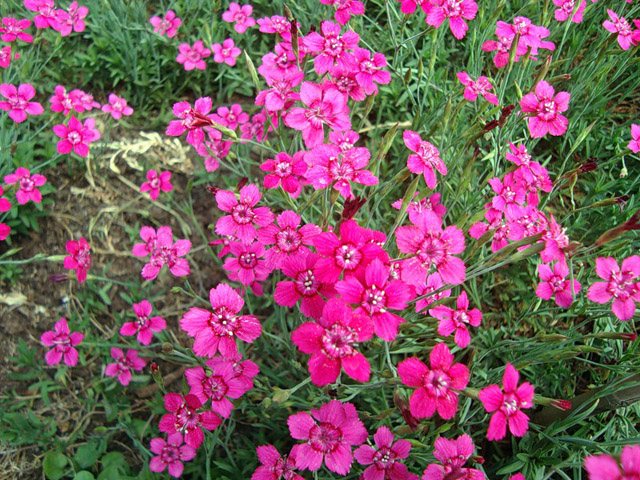

Illumination. Crops require as much sunlight as possible - it is best to use a bright area and an indoor window.- Watering. Indoor plants with pink buds are important to water abundantly. It is important to give the soil mixture time to dry between waterings.
- Air humidity. You need to spray the foliage regularly.
- Breeding features. The plant can be propagated by cuttings in early spring. To do this, you need to use special hormones for the rooting of flowers.
Indoor flower medinilla: reproduction and care
Combination with other colors
In order for the garden to look wonderful in the photo and in reality, it is necessary to correctly combine the plants. Color plays an important role in this. The main rule is that flowers should be visible on the flower bed, and not a blurry spot of different colors.
- If you like everything bright, you should combine white plants with rich ones. If you are a gentle and romantic person by nature, flowers should be white and pastel shades.
- An excellent combination is represented by plants of red, blue, yellow and green colors. They should be combined with white flowers. The flowerbed in this case will look three-dimensional.
- It is better to take purple, green or blue flowers as the main tone of the flower garden. Yellow, red and orange plants add warmth. White will dilute bad combinations: blue and green, orange and red, purple and red.
What are the names of rose cultures
Most often, gardeners plant hyacinths and muscari on the site. Pink flower names:
- Hyacinth - a flower with small pink flowers. This culture is considered especially popular with gardeners. It is customary to plant it in the soil at the end of September, keeping the outside temperature from 6 to 10 degrees Celsius. Before the onset of low temperatures, the hyacinth will have time to qualitatively adapt and root the roots, having overwintered under the film, with the onset of spring, the culture will begin to sprout tender sprouts first of all, and then it will completely bloom.
- A perennial culture is considered a relative of this plant - muscari... Its inflorescences are painted in a pale pink shade. The plant is often used for wedding bouquets. Florists most often plant muscari in alpine hills. The culture is distinguished by a high indicator of unpretentiousness, it can bloom freely in places both shaded and well-lit. In this case, it is important that the flowers are not in an elevated place, as they are negative about excess moisture and may begin to rot.
How to make bloom at home?
In order for flowers to please the eye of the owner all year round, they need to create suitable conditions. It:
- a sufficient degree of humidity (not only watering, but also irrigation of the leaves), especially in hot weather;
- normal illumination, without direct sunlight (many varieties require a light shade);
- loose soil in which roots will develop faster. To do this, you need to mix the soil in equal parts with sand and add charcoal;
- timely pruning.Withering buds and leaves must be removed in time, because they consume nutrients, but do not add attractiveness to the plant. If you cut them off, the next flowering period will be more abundant. Thorough pruning in late fall is recommended to prepare the crop for the winter dormant period.
Dissolving flowers in autumn
With the onset of autumn, pale pink inflorescences that look more like pompons appear on hydrangea bushes. It is really hard to look away from this plant. Such a flower is distinguished by some capriciousness and instability to frost, but the effect of beautiful round-shaped inflorescences can surpass all the hassle of growing it.
The modest heather variety Radnor, although not particularly remarkable, can decorate flower beds before the onset of cold weather with its tasty and pleasant smell. Versek prefers to grow in sunny places and is not afraid of liquid stagnation. The lifespan of this culture, with proper care, can be up to fifty years.
The euonymus will help revitalize the site with its raspberry inflorescences and openwork crown, which makes the plant look like a brooch. Even after all the leaves have fallen from the plant, it will continue to delight the eye of the grower with its bright fruits, which remain on the plant until the onset of winter. Depending on the specific variety, the shade of the flower can be lilac, pink, bright red and burgundy.
Additional landing rules
A number of other rules should be followed:
- It is recommended to arrange large plants with small ones - gypsophila, alissum, iberis.
- White roses always dominate other plants.
- For a large rose, it is recommended to use silver wormwood as a neighbor.
- Alyssum looks great with viola.
- White viola can be planted with blue forget-me-not.
- For vertical gardening, you can use clematis and climbing roses - red and white looks very impressive.
Features of flower beds of white perennials
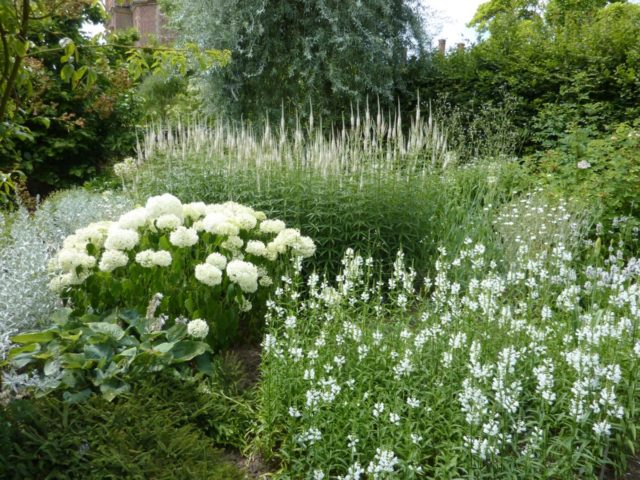

Each color has its own magic, evokes certain emotions and a state of mind. But, perhaps, most people associate only one with lightness, elegance, grace and purity - white. Beds of white flowers visually expand the territory of the garden, bring a feeling of lightness and airiness. Landscape designers advise to design them in recreation areas, near a gazebo or a pond. Then, while walking, you can enjoy the splendor and radiance of white to the maximum, the state of mind will become more calm and peaceful.
However, it is a mistake to think that it is quite easy to arrange a one-color flower bed. With a competent design approach, one should take into account both universal tips for creating flower beds, and recommendations that will help to harmoniously embody the idea of monochrome.
When developing a flower bed project plan, you need to take into account the following nuances:
- White flower beds look favorably against a contrasting background of hedges or mowed lawns. But you should avoid light-colored buildings and fences.
- When choosing white perennials, one should take into account their requirements for soil quality, illumination, and watering frequency.
- Perennial plants should make up at least 50% of the total number planted in the flower bed. Annuals will be an important addition as they have earlier and longer flowering periods.
- In the structure of a monochrome flower garden there should be 3-4 tiers. In the lower one, ornamental grasses should be actively used, and in the highest - vines, shrubs or trees.
- Plants with different shapes of flowers and leaves should be placed in the neighborhood in order to avoid visual monotony.
- It is recommended to plant at least three copies of the same species.
- It is necessary to take into account the time of plant budding. At least two species should bloom on the flowerbed at the same time.
Echinacea and irises
Flowers of the Delilah variety are colored in a light pink shade and raise their heads on high and thick legs upwards.Flowers can decorate the garden well while the early spring and late summer crops have finished blooming. But it is important to remember that such a plant needs a special garter, since its height does not actively resist gusts of wind, as well as precipitation on the street. Unfortunately, irises have a relatively short flowering period of only five days, but the attractive leaves continue to delight the gardener's eye throughout the summer.
In summer, the flower beds are decorated with a flower similar to pink chamomile - echinacea. The culture is easy to care for, can withstand drought, low temperatures, and also grows even in nutrient-poor soil. It can also be noted that this plant has medicinal properties that help alleviate the condition of a person with arthrosis, inflammatory processes in the oral cavity and in the presence of dangerous female diseases.
Tenacious
A little later, an oak tree, or tenacious, appears. She can settle in the garden herself, quickly spreading, mastering new territories. The flowers are purple, similar in shape to snapdragons. The leaves are dark green with a purple tint. The flower lives up to its name. If you do not monitor its habitat, the tenaciousness can spread to the entire site. This applies not only to wild plants, but also varietal plants. The area where the tenacious grows does not need to be weeded, because the weeds will not be able to break through the dense cover.
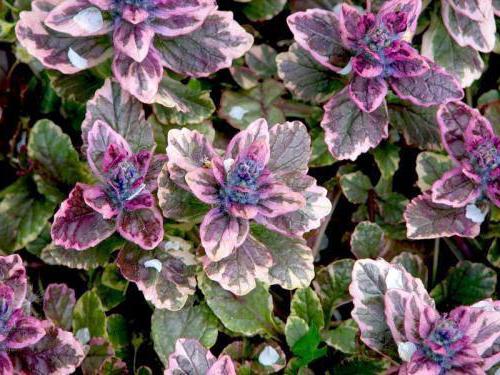

Ornamental varieties differ mainly in the color of the leaves. It can be marbled, crimson, or green with white spots. The excess mustache of the tenacious must be periodically removed so as not to miss the plant outside the allotted area.
Using white plants in garden design
You can use white plants in the design of the garden in different ways:
- create ceremonial white flower beds or ridges;
- arrange light spots on the lawn or in the meadows of ground cover;
- highlight dark or gloomy corners of the garden;
- use them as a thinner in colorful ensembles and flower beds with a bright palette (white colors bring harmony);
- highlight dark greens with them;
- to emphasize soloists with bright colors (for example, roses);
- to create optical illusions - to play with the perception of close and distant objects, push the boundaries, create "trickery";
- to bring the effect of illumination to places where there is not enough light;
- create a festive, joyful atmosphere and highlight cheerful accents;
- to bring structure and expressiveness to the composition with a stake on unpretentious plants;
- to emphasize the beauty of objects of small architecture, etc.
If you wish, you can even create a lunar or white garden - decorate your site in such a way that white dominates in the absolute. But even one white flower garden is not necessary to complete in order to appreciate the importance of plants with a light color in the design of the garden: white plants will show themselves, even if there are only a couple of them.
There are white stars both for the beginning of the season and for its second half.
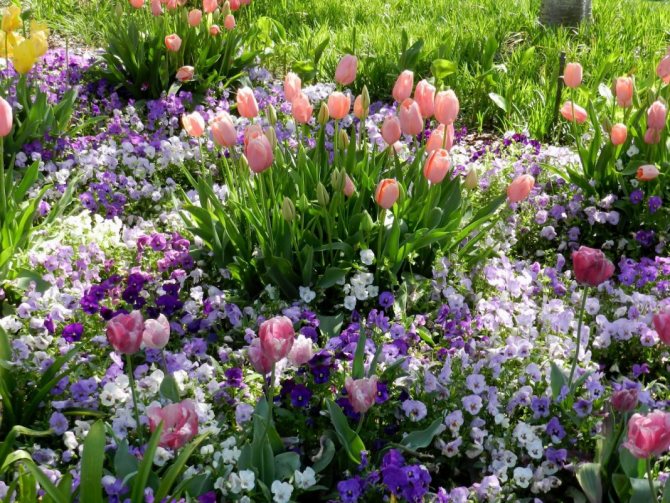

Tulips framed with white violas to enhance the contrast. <>
Rowleyanus
Among indoor plants there is a flower with small leaves of an original shape. This is a Rowleyanus cultivar (senezio). Its filamentous stems hang down. They are covered with small spherical leaves up to 1 cm in diameter. Rowleyanus inflorescences, the same size as the leaves, are white.
Most often, rouleianus is used as an ampelous plant, but can be planted in a large bowl along with a tall bush. Then it spreads over the surface of the soil, covering it.
Like any succulent plant, the groundwort must be watered carefully. It does not require a lot of water even in summer. In winter, watering is limited even more. Make sure that the soil in the pot does not dry out completely. The temperature is lowered to 7 degrees Celsius.
The plant is poisonous.The use of individual parts will not lead to a rapid death, but with the constant ingestion of succulent poison in the body, it can cause cirrhosis or liver cancer. All parts of this seemingly pretty plant are poisonous.
Arends' saxifrage
Arends' saxifrage is one of the most beautiful species of this plant. Its small but beautiful flowers adorn alpine slides and flower beds. Saxifrage is a very unpretentious plant. It can settle and grow successfully on rocky slopes, in gorges. The higher it grows, the brighter the colors of flowers and leaves. The plant itself belongs to bryophyte sod hybrids. It is frost-resistant, undemanding to growing conditions.
Arends saxifrage varieties with various petal colors have been created. They can be white ("White Carpet"), purple ("Purple Carpet"), pink, carmine red. The flowers rise high above the sod, leaving only thin brown stems in the middle. Peduncles must be removed after the flowers have faded on them. This promotes long-term flowering. These plants reproduce with small flowers, seeds, dividing a bush or cuttings.
Seeds are sown in a box in March. The soil should be loose, drained, contain peat, sand and deciduous soil, humus. Do not overmoisten the soil in the dishes where the saxifrage grows. After three weeks, the plants are ready to dive.
Propagating saxifrage by cuttings, they are placed under glass in boxes set in the shade. The temperature there should be about 22 degrees. Maintain high humidity by watering the soil as needed.
The bushes are separated in early spring or autumn. Saxifrage is planted in shaded areas. If you plant it in a sunny area, you will need to provide the plant with daily watering.
Replacement plants, temporary accents and white "rescuers"
No matter how carefully you think over the introduction of white plants into the garden design, from time to time you will have to face the task of urgently "saving" the compositions and adding small highlighting accents to them or replacing plants that lose their attractiveness too quickly. Mandatory replacement is needed only in one case - for spring stars.
The choice of white accents for decorating a spring garden is great, but since bulbous ones dominate among such crops, so that after they leave the garden scene, the compositions do not acquire a sloppy, sloppy look, you need to think in time to transfer the baton to plants that can replace them not only in terms of their role in ensembles, but also according to the talent to decorate the garden for a longer period of time.
Different cultures can be planted to replace early flowering plants - both perennials, which wake up late enough and hide the dying leaves of tulips and Co. with foliage, and annuals, which will bloom tirelessly until the very frost.
Among the perennial “replacements” for spring white stars, the best candidate is the host of variegated varieties, the white patterns on the late emerging leaves of which can fully replace any flowering plant. But primrose, perennial violets, liverwort, and daisies will cope with the task (however, they will have to be transplanted and divided every year, at the end of June, so that the plants do not degenerate like ordinary biennials, but remain in a perennial culture).
Among annuals, attention should be paid to scented tobacco, petunia, tuberous begonias, balsams, snapdragons, annual asters, ageratum, lobelia and alissum. All of them have white cultivars, and it is better to make the choice according to the desired size of the "concealer".
The same summer gardeners can be used as “helpers” for any unexpected situation - a clearing or emptiness on the flower garden, a situation when certain parts of the flower garden become boring and you want to add color and light to the composition.
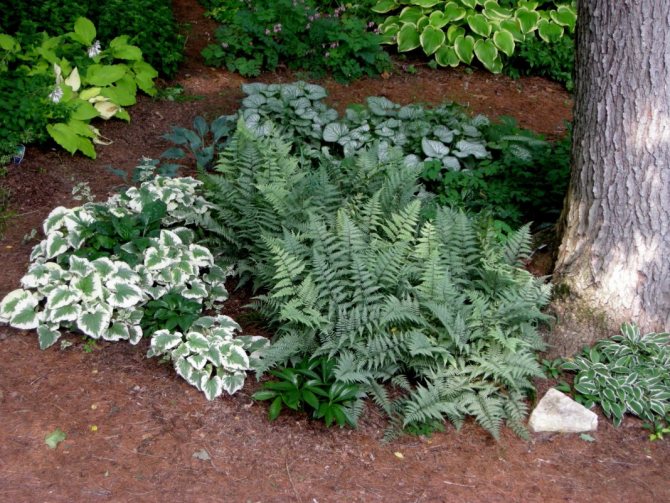

Flower garden with decorative plants with white leaves.
What are the unpretentious care?
Such plants require a minimum amount of attention, infrequent watering, they tolerate shade and cool air temperatures, are undemanding to humidity and other indicators.
These include:
- plumeria;
- eucharis;
- hoyu;
- spathiphyllum;
- hydrangea;
- echinacea;
- clematis.
Attention! Despite the undemanding nature of these crops, they still need minimal care.
Otherwise, the plants will get sick, wither and die.
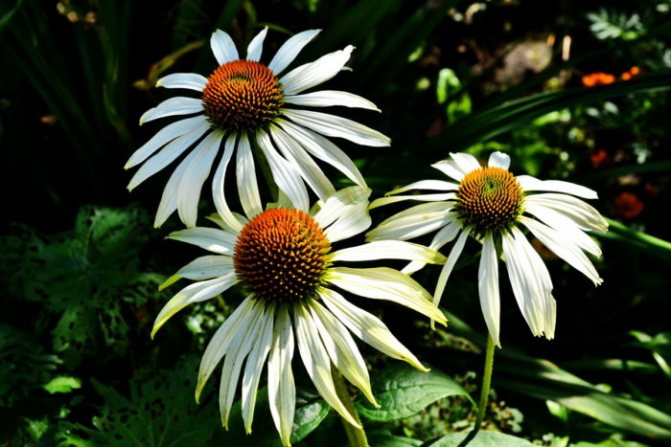

Healing properties
The chemical composition of the snowberry is poorly understood, so the plant is almost never used in folk medicine.
But in North America, where the shrub is found throughout the territory, the indigenous people have learned to use it for treatment. They know about the antimicrobial and disinfecting properties of the white snowfield and prepare drugs from its berries, bark and leaves to treat wounds.
The shredded leaves of the shrub are used to fight skin ulcers. Compresses made from crushed fruits are used in the treatment of burns, cracks on the skin surface. Infusion of the bark from the plant is good for sore throat, as well as for many other diseases:
- tuberculosis;
- menstrual pain;
- venereal diseases;
- stomach pathology;
- cold.
Despite these properties, it is not recommended to self-treat with these poisonous agents without consulting a specialist.
The original berries of the bush are beautiful in appearance, but unpleasant in taste. When poisoning with the fruits of the snowfield, the following symptoms are observed:
- nausea and urge to vomit;
- paroxysmal pain in the stomach;
- burning sensation in the mouth and throat;
- feeling weak and dizzy;
- stomach upset;
- lethargy.
If the poisonous substances of the plant get on the skin and mucous membrane, there is swelling, redness and irritation of the skin. The victim experiences painful sensations, the intensity of which will depend on the affected area. The individual characteristics of the organism also matter.
Read also Pomegranate peel: medicinal properties and use in medicine
When the plant poison gets on the skin, it is recommended to immediately rinse the affected area with water. When ingested, symptomatic therapy is performed. It is necessary to drink milk, which has the ability to neutralize poison, or activated carbon. If the condition is severe, then you should immediately seek medical help.
Brandy, tulips and phlox
Tulips are more unpretentious than hyacinths. They tolerate winter well, but they like sunny and sheltered places from the wind. And they delight the eye with a variety of colors - these can be yellow, bright red, white flowers, pink, even variegated.


As soon as the snow melts, branduchki settle in the garden - rather vulnerable plants related to primroses. When planted in a group, they form a pleasing purple-pink carpet that looks great in flower beds, especially in combination with violets and buttercups.
Even if you do not have the opportunity to worry about the variety of flowers in the garden, phloxes can decorate it with all shades of pink from spring to autumn. These plants are hardy and have a large supply of vitality. But they do not like close proximity to trees and shrubs with an extensive root system. Phlox loses in the fight for light, water and food.
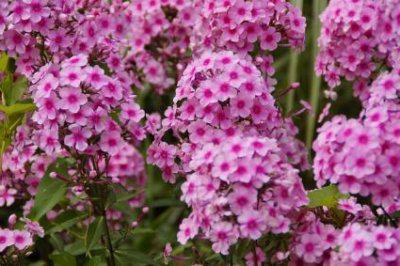

Cut flowers for bouquets
Flower names and short descriptions give budding florists an idea of popular flowers that can be used in bouquets.
Alstroemeria. Pleases with a rich color palette and excellent durability. In the cut, they can stand for 3-4 weeks. They are suitable for people with increased sensitivity to fragrances, since they are odorless.
Anemone. The flower is called an anemone for its light and delicate petals that fall off in strong winds. The color scheme of anemones, similar to poppies, is varied. But most of all they love to add them to winter bouquets. A rich blue anemone looks unusual and mesmerizing.Frequent guest in the design of blue wedding bouquets. We even have a separate article dedicated to only blue colors in compositions. Click here and the article will open in a new window.
Aster. This is a favorite flower in an autumn bouquet. An aster, which looks like a star, is presented not only to teachers, but also to beautiful women. Aster will be an interesting element in the wedding composition.
Carnation. A correctly assembled bouquet of carnations will not be inferior in beauty to bouquets of roses, so many florists choose a delicate carnation for bridal bouquets.
Gerbera. The solar gerbera will add brightness to any bouquet. The flowers are like multi-colored daisies and symbolize the joy of life. Gerberas go well with irises and orchids.
Hyacinth. Spring flowers with delicate hues that look good in pastel bouquets.
Hydrangea. Lush hydrangea inflorescence allows you to create adorable mono bouquets that look touching in the hands of the bride.
Iris. A bouquet of irises looks sophisticated, such a composition is an excellent birthday or anniversary gift for a woman or a man.
Lily of the valley. A flower made of small lilies is a good gift for young girls. In wedding floristry, a bouquet of lilies of the valley is complemented with decorations.
Lily. A bouquet of lilies is a royal gift. Lilies in a flower arrangement can be combined with roses, to which they are slightly inferior in popularity.
Daisies and Aubriets
Daisies are flowers especially popular with gardeners. Their small stature, terry inflorescences and a wide range of shades turn this plant into the main decoration of the garden. Yellow-pink daisy flowers will bloom the flower beds in bright spots until October. With proper care, you can grow a whole flower bed of these sunny flowers from one bush.
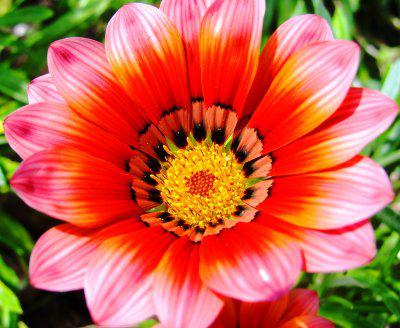

And evergreen aubrieta is able not only to endure frosts, retaining its leaves and color, but also to delight you with a lush cap of racemose inflorescences. Each of her flowers - pink or any shade from purple to blue - is small and modest, but together they make up a lush, colorful pillow. This herbaceous, undersized shrub grows wide and leaves almost invisible under its flowers.
Small flowers in the garden
In early spring, the small flowers bloom first. They are called so: primroses or ephemerals. They received the second name because soon after flowering, the aerial part disappears. A bulb remains in the ground, which next year will again delight with flowers. Small flowers are named: snowdrops, chionodox, white flowers, pushkinia, blue-leaved woodland (blue snowdrop), double-leaved woodland. They delight everyone who sees them, because they testify to the arrival of spring. These plants do not require special care. They need to be planted periodically so that the bushes do not become very thick. Otherwise, they will stop blooming, and then completely disappear.
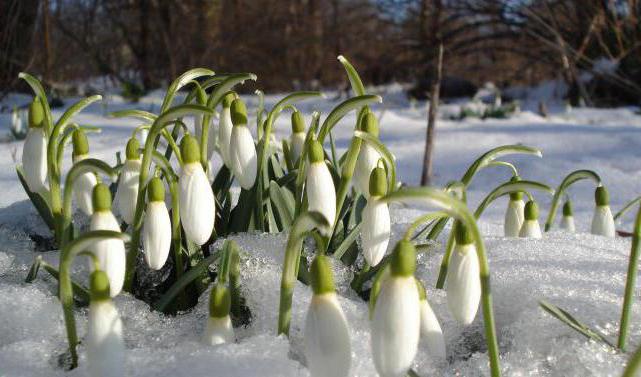

After the primroses have faded, other plants appear with small flowers. Muscari bloom, delighting with delicate blue bells gathered in dense inflorescences. Another name for the flower is mouse hyacinth. In the shape of the inflorescence, it really resembles a hyacinth, only its flowers are much smaller. Propagated by dividing the bush or by self-seeding. Bushes grow rapidly, the number of peduncles increases. From these flowers, they create borders for large-flowered tulips, daffodils blooming at the same time. Flowers are blue with a white border, purple, white. Dried stems with fruits are used to create winter bouquets.
The five best perennials for a white shady flower garden
Weightless clouds of astilba
Astilba (Astilbe), presented on the market today with a large assortment of various bright hybrid varieties, invites you to admire not only warm pastel colors. Snow-white astilbe is in no way inferior in popularity to pink varieties.
For example, the unique varieties "Bridal Veil" or "Brautschleier" can attract admiring attention.Weightless, lacy, as if covered with a cloud, astilbe are plants that combine simplicity with a spectacular appearance. For the decoration of flower beds located in the shade, they are irreplaceable.
Astilbe - herbaceous perennials, for the beauty of their flowering have earned the nickname false spirea. Despite the fact that astilbe completely disappear for the winter, during the entire active gardening season, from the moment the first bright leaves bloom until the beginning of fruit ripening, one can only admire them.
Basal leaves are three times - or double-pinnate, openwork, with a very beautiful pattern and a rich color that stands out brightly in shady flower beds. Small, almost indistinguishable flowers are collected in huge weightless panicles of inflorescences that bloom in June-July.
Frost resistance: from the 4th to the 9th zone.
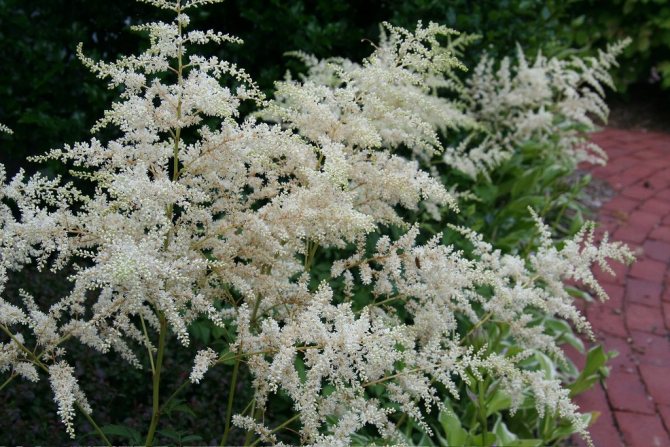

Astilbe. <>
Graceful shy mountain woman
Among compact perennials that will help create a truly lush white flower garden and easily decorate the foreground of any flower bed in a place where there is modest lighting, lush mountain woman (Epimedium x youngianum) occupies a special place.
This is an elegant perennial that looks very delicate, luminous and forms dense bushes, but the elegance of its details can only be seen up close. The plant fully justifies the nickname of the elf flower or bishop's hat and, in fact, is the main competitor of aquilegia. Mountain women have both pink-flowered and white varieties, such as the charming Niveum variety.
Lush mountain goats are herbaceous perennials, limited to a height of 25 cm. The feathery leaves, adorned with neat “leaves” of lobes, change color from bronze to dazzling green. On the thinnest, almost threadlike, but strong peduncles, loose inflorescences bloom, consisting of hanging graceful flowers that soar above the plant, like fairies.
Frost resistance: from the 4th to the 9th zone.
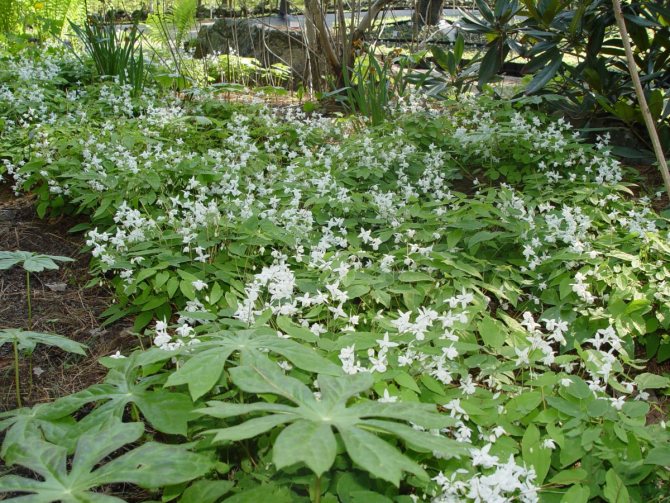

Horny Goat Weed "White Star" (Epimedium x youngianum). <>
Shining tears are bought
Among the plants that always attract eyes in the shade, fragrant bought (Polygonatum x odoratum) has rightfully earned the title of a special favorite. There are not many varieties of kupena, but they are all special. Modern varieties, obtained on the basis of variegated medicinal kupena, flaunt with variegated white-green leaves.
The fragrant varieties "Solomon Seal" will fit perfectly into the shady white flower garden.
Kupeny are herbaceous perennials with thickened roots and shoots curving arcs, which surprise with their strict edges. The height of the bushes is 60-90 cm.
Linear or elliptical leaves are sessile, hugging the stem, due to the elongated base, they are located on the shoots in the next order, resembling the leaves of zamiokulkas. The color is lighter than that of most perennials, the leaves persist for an amazingly long time.
Flowers bloom in the leaf axils. Bell-shaped, drooping on a thin peduncle, they seem to be a drop or a pearl peeping through the greenery. The whole plant as a whole looks amazingly graceful.
Frost resistance: from the 4th to the 8th zone.
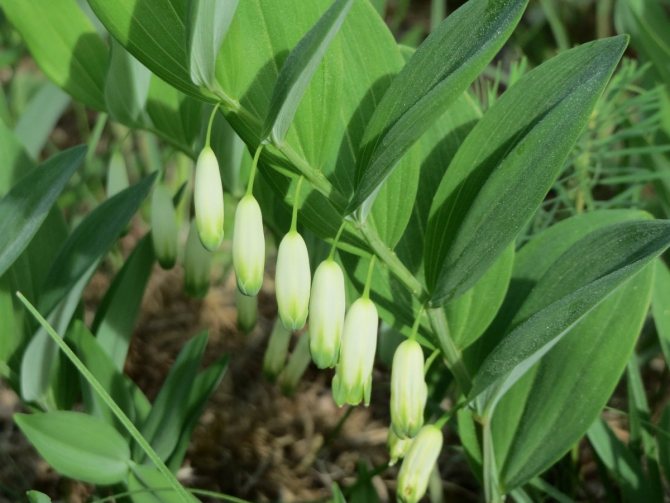

Fragrant Kupena (Polygonatum x odoratum).
Immodest tiarka
Among shade-tolerant perennials Tiarella Verry (Tiarella wherryi) is a true legend. A charming plant with dense bushes of beautiful leaves, covered with an openwork canopy during flowering, will not be lost on any flower garden. Among the varieties of tiarella of this type, pink novelties are in special demand, but they lose the brightness of the foliage. If you choose a classic for a white flower garden, the greenery and tiarella bloom will surely surprise you pleasantly by being in the foreground.
Compact, up to only 30 cm high, with dense bushes of leaves, it amazes with the beauty of large curly leaves of a bright yellowish-green color, forming almost round rosettes. Tiarella Verri does not sprawl like her relatives, but grows in the form of dense bushes.
Small flowers in loose cylindrical racemes rise on thin, dark peduncles, creating an unimaginable lace effect. The star-shaped flowers are very beautiful in and of themselves. And the contrast between light pink or white inflorescences and dazzlingly bright greenery makes flower beds especially elegant. Thiarella blooms in early May for more than a month.
Frost resistance: from the 4th to the 9th zone.
Tiarella wherryi. <>
Irreplaceable variegated hosts
It's hard to find an ornamental leafy plant that offers just as much of a delightful variety of white fringes, spots, or ripples on its leaves as a favorite for decorating a secluded garden. host (Hosta). The brightest white border, characteristic of the Patriot variety, looks no worse on the flower garden than the inimitable Undulata, in which the white spot stretches from the middle to almost the entire plane of the leaf, the Firework variety also looks beautiful, with subtle dark strokes ".
The hosts are easily recognizable large-leaved herbaceous perennials. Due to the short rhizome, they constantly grow in breadth, but this does not change their pattern and ornamentation. Basal, on powerful petioles, heart-shaped or narrow-lanceolate, ovoid or oval leaves create almost tiled patterns.
But the hosts also bloom very beautifully. Naked tall peduncles, in contrast to compact, not exceeding 30 cm curtains, grow up to a meter in height and are crowned with clusters of inflorescences of graceful bells. White-leaved hosta varieties also have white flowering. Among the flowering varieties, there are also specimens with a white color range of inflorescences.
Frost resistance: from the 4th to the 9th zone.
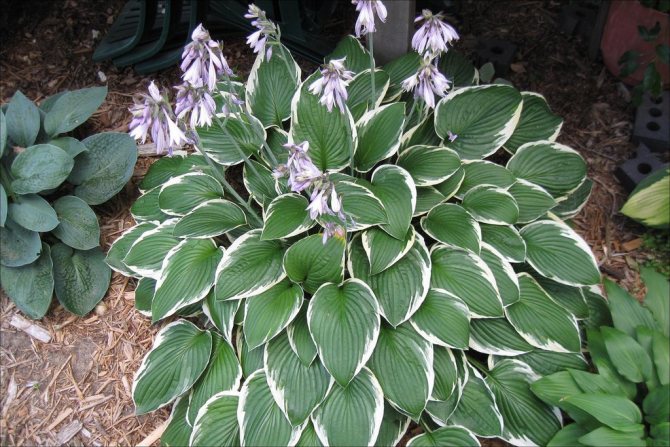

Hosta. <>
Snow berry care
The snowberry is an unpretentious plant, it adapts to growth on poor, dry and moist soils. It is able to grow in full sun or partial shade. It has strong underground rhizomes, so planting it on slopes helps with soil erosion.
Landing
Planting the "snow berry" spend in spring, or in early autumn. For young animals, you should choose areas that are slightly shaded.
An adult plant can survive on arid soil, the root system of which is able to receive moisture from the ground on its own. Young shrubs will need watering to form roots.
Step-by-step landing instructions
- For the initial planting, you will need to create a quality substrate; a mixture of sand, humus and turf can be used as a suitable soil. Pour drainage (crushed stone or expanded clay 10 cm) at the bottom of the planting hole.
- Planting root set as vertically as possibleby slightly straightening its lateral branches. The neck of the bush should not be buried; it should be at the level of the soil.
- Sprinkle with prepared soil, slightly shaking the plant, helping the soil to occupy all the cavities between the rhizomes.
- After planting, compact the soil and shed water. Watering should be carried out within 3 weeks, in the absence of precipitation.
- It is better to tie a young bush to a support until it gets stronger.
- Taking into account the growth activity, the distance between plantings must be between 0.7 meters.
Spring Summer Care
In the spring, when the soil thaws, you need to dig it up around the bush. Cut out all dead wood with pruning shears. Fertilizing a snow berry is optional, but desirable. Compost or humus is used as a top dressing.


Digging up a flower bed in the spring is good for the plant.
Pruning
If the "snow berry" shrub plays the role of a hedge, its crown is pruned in order to form a decorative and well-groomed form. Pruning time April-May, before the season of active sap flow.
Watering
For adult bushes no watering needed, and young animals can be pampered with water in a drought. Tap water can be used, but standing water or rainwater is best. Charcoal is used to soften the water.
Autumn-winter care
The snowberry does not require any additional care in the fall. Watering and feeding at this time should be stopped. The shrub is frost-resistant and does not require additional shelter (with the exception of the rarer pink varieties).
Secrets of White Permanence for Flower Gardens
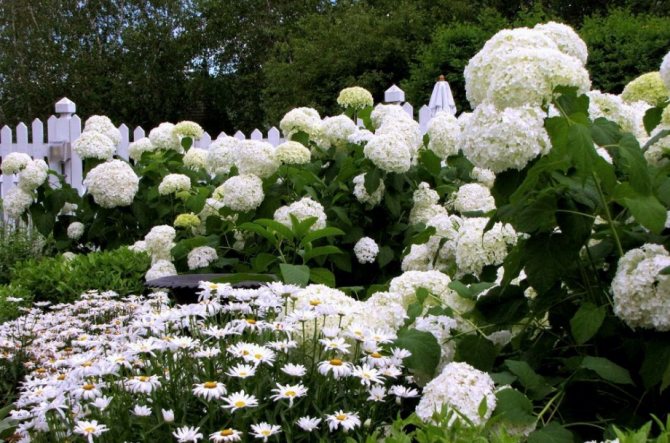

It is almost impossible to find pure white in the garden. The same rule applies to black. Garden plants are often perceived as white when they come close to this palette. We are talking about cream, pink, light blue, light green or lilac. But when compared with the original, the whole play of shades becomes clear. If we talk about the principle of the influence of white colors, then they are the same.
Attention!
When creating a monochromatic flower garden in the country with an emphasis on a white tone, it should be taken into account, this is a conditional name. In fact, I mean compositions of 2 different shades, because white is an addition to a brighter one.
Green leaves emphasize the attractiveness of light and make them brighter. If you want the color scheme of the flower bed to be exactly white, then you should take into account some aspects and nuances of greenery that can enhance this effect, or vice versa, the feeling of the predominance of whiteness will be ruined. When decorating light areas, designers recommend not avoiding coniferous or deciduous bushes.
To make a snow-white flower garden beautiful, you should take care of its appearance in autumn and spring. There are few crops blooming white, the growing season of which occurs at the beginning and end of the summer cottage season. The flower bed will be empty or ugly until the inflorescences open or after they fall, so you need to prepare plants with bright foliage in advance. In addition, all flowers must be in perfect condition. You also need to play on the shapes and sizes of crops. If the inflorescences are small, then they must be combined with large ones.

